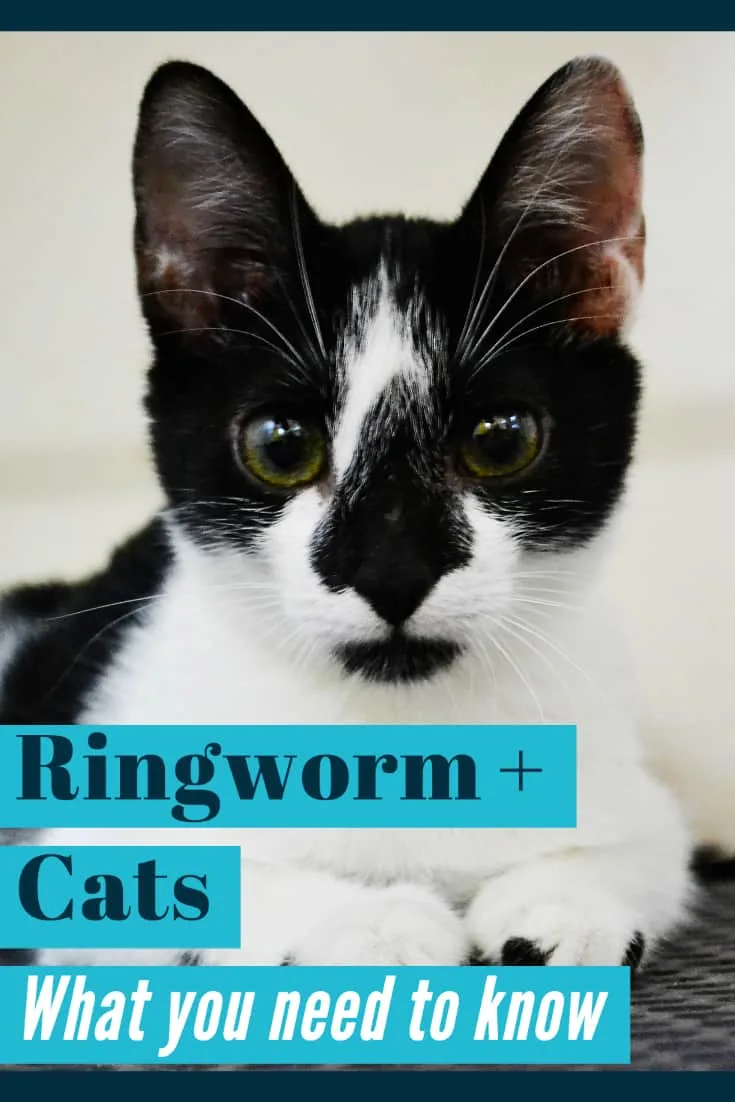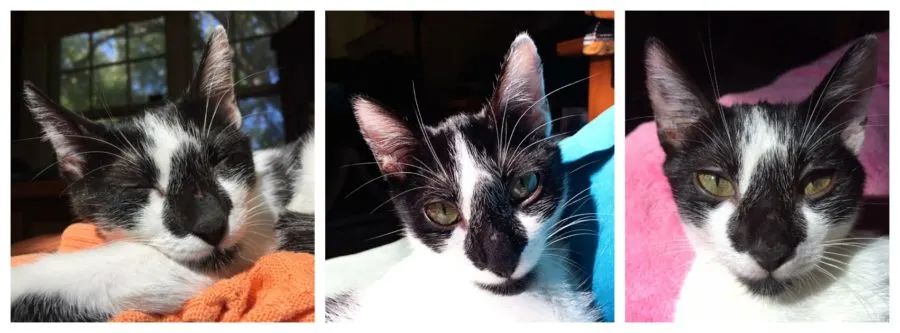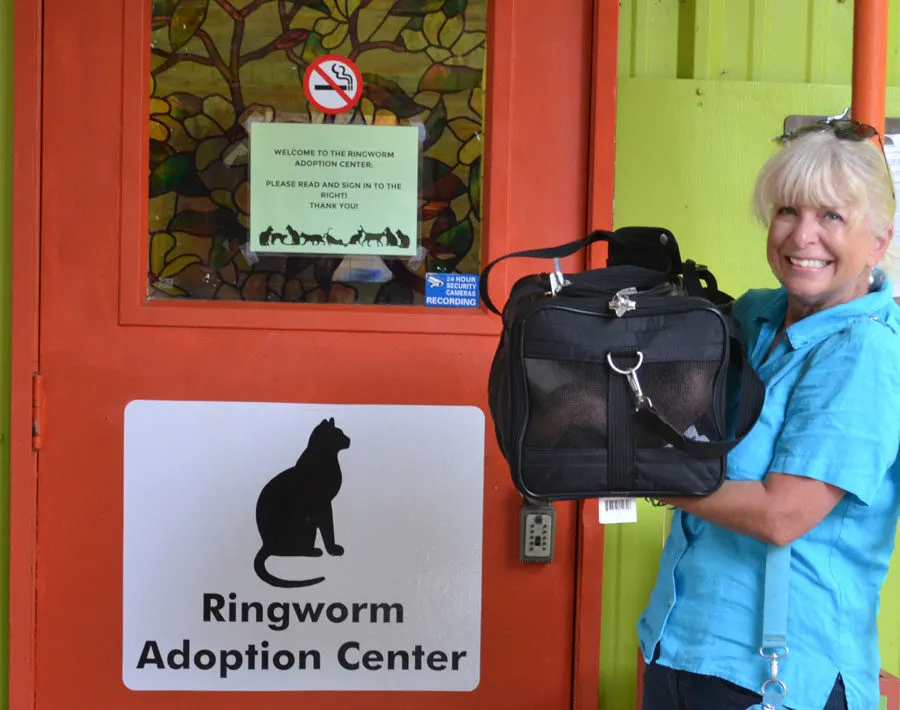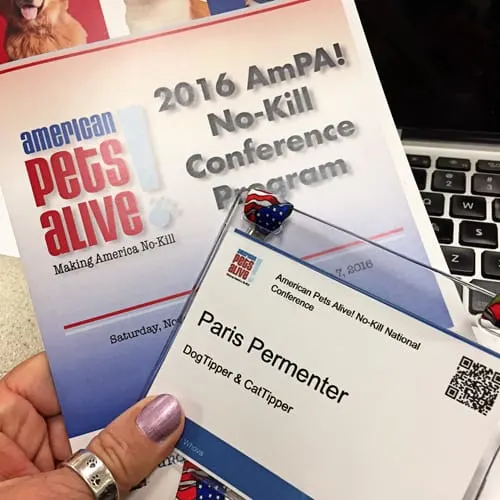Do you suspect that your cat has ringworm? Ringworm in cats is a common skin condition and one that, with some treatment and time, can be cured–but you do need to take care not to spread the ringworm to your other pets or to yourself.
“Ringworm is one of the most common causes of hair loss in cats and is one of the first things to consider if a cat is losing hair,” explains Dr. Alison Diesel, clinical assistant professor at the Texas A&M University College of Veterinary Medicine & Biomedical Sciences. “This is an infectious fungal disease that is zoonotic, meaning it can affect other animals and people,”

What is Ringworm?
Ringworm in cats is not a worm at all. In spite of its name, ringworm–or dermatophytosis–is merely a fungus. The fungus affects the hair, skin, and nails of pets and people.
Ringworm can cause scaly patches, hair loss and inflammation around the circular lesions on the ears, paws, legs and head.
Although the fungus is unpleasant, causing itchiness and hair loss, its effects are largely superficial. Nonetheless, ringworm can be deadly to cats in shelters, putting cats at risk for euthanasia because shelters don’t have the manpower to handle treatment.
Identifying Ringworm in Cats
Of course, before cats can begin treatment, they must first be diagnosed with ringworm.
Hansen’s advice included having multiple people look at the incoming cats, consider the history of the cat (felines from hoarding cases or ones residing with other ringworm cats are more likely to carry the fungus), know the signs of hair loss in cats (unlike with people, cat ringworm isn’t often circular), feel the cat, and check for crusty skin, especially on the ears, paws and tail.
Very young, old, sick and stressed cats are most at risk.
A Wood’s Lamp is also a way to check for the fungus. Fur with fungus will glow green. When our cat Ochi was cleared of ringworm, I sat with her while the vet went over her with a Wood’s Lamp–no more glowing green!
Can You Get Ringworm from Your Cat?
The short answer: yes.
Veterinarian Dr. Audry Harvey reminds cat lovers to make sure they don’t get ringworm. (I can attest that it happens–I contracted ringworm when we adopted Inca.)
“Don’t forget to look after yourself. Watch out for any little red scaly lesions on your skin. If you find any, have it checked by your doctor to confirm that it is in fact ringworm, and to get an appropriate treatment.”

As you know, our kitten Ochi was adopted from the Austin Pets Alive! Ringworm Adoption Center. The center, housed in a separate building on the campus of the downtown Austin rescue, serves as a temporary home for 45 cats at a time–each with ringworm.
When we went to see Ochi at the Ringworm Adoption Center, we had to sign a waiver to enter the building, which is a dedicated ringworm ward, stating that we knew the risk of catching ringworm ourselves and that we knew that we would not be allowed to visit the general cat adoption ward that same day, since we could be carrying the fungus on our clothing.
Can Other Pets Catch Ringworm?
And, along with the possibility of you catching ringworm from your cat, your other pets can also catch ringworm from an infected cat.
“You definitely need to worry about your other pets – and yourself!” explains veterinarian Dr. Audrey Harvey. “Ringworm is highly contagious, and it’s not just spread by close contact; it can be transmitted by things such as bedding, collars and brushes. Whether or not your other pets have picked up the infection depends on how much contact they have had with your new cat.”
While cats–whether in a shelter or in your own home–undergo treatment, they need to be kept separated from other animals so as not to spread the fungus.
But the ringworm fungus doesn’t just lie on fur–it also hides out on surfaces that are difficult to disinfect: wood, carpet, and porous surfaces like scratching posts. Even your clothes are ready to harbor the fungus.
If you identify ringworm in your cat or adopt a cat with ringworm, step one is isolation.
“To minimize the risk to your other pets, isolate your new kitten as much as possible,” says Dr. Harvey. “Bleach all your feeding bowls to prevent cross-infection, and do the same with grooming equipment. Vacuum your home, and throw the vacuum bag out straight away. Lastly, wash your pet’s bedding in bleach, and hang in the sun to dry.”
And as for your other pets? “You then have two options. The first option is to adopt a ‘wait and see’ attitude. Keep an eye on your other cats, and watch for any signs of ringworm. If it shows up, then have them treated.”
You can also be more pro-active with treatment. “The other option is to treat them just in case. An anti-fungal shampoo or conditioner is an inexpensive way of removing fungi from the skin and fur. Either option is perfectly acceptable.”

Treating Ringworm
As mentioned by Dr. Harvey above, there are anti-fungal shampoos and conditioners.
Both Ochi and Inca were treated with a lime-sulphur dip; after their adoption, we were sent home with dip to continue.
Talk with your veterinarian to plan the best course of treatment for your cat so that you can resolve the fungus as quickly as possible.
At the shelter, cats who are in good health, at least eight weeks old and 1.5 pounds, and at least one week post-neuter or two weeks post-spay are bathed twice a week in a lime-sulphur dip. (I’ll be honest: it’s a dip whose smell you’ll never forget.) They’re also treated with an oral medication.
How to Help Shelter Cats with Ringworm

A few years ago, I had the opportunity to attend the American Pets Alive no-kill conference, organized by Austin Pets Alive!
One of my favorite sessions was “Fighting Fungus: How to Build a Treatment for Cats with Ringworm,” led by Kristen Hansen, APA’s Ringworm Adoption Center Manager, the very person who handled our adoption of Ochi just months earlier.
Austin Pets Alive has done such a super job of saving cats with ringworm, ones who might not have made it out of area shelters. (Ochi was originally from the Lockhart city shelter.)
Saving those ringworm cats is one way Austin has been able to achieve its status as a no-kill city. Austin Pets Alive provides a safety net for these at-risk cats as they undergo treatment.

“Ringworm cats are one of the most at-risk cats in the rescue model,” explained Hansen. “In most models, cats with ringworm are euthanized immediately. In the no-kill movement, we want to start saving these cats and turning these unadoptable cats into adoptables.”
It’s an effort that takes work–often months of work. Our Ochi, who had numerous ringworm breakouts across her body, was in the care of the ringworm ward for just over three months, although the average stay of a cat before either graduating to the general shelter population or being adopted is 48 days.
How can YOU help ringworm cats in your community? Here are five ways to help:
Foster Ringworm Cats
Austin Pets Alive has an large, active base of foster families that help foster pets. Ask your shelter about the opportunities for being a foster to a cat with ringworm. It’s not as simple as fostering a typical cat: you will need to isolate the cat in an easy-to-clean room, dip the cat twice a week (although Austin Pets Alive offers to dip cats for fosters), and even change clothing after cuddling with your foster kitty.
Donate to Help Your Shelter
Talk with your local shelter about their needs for ringworm cats. From inexpensive bleach (which you can pick up at the dollar store) to Kuranda cat towers which are easily sanitized, shelters have special needs for their cats with ringworm.
Cardboard tubes from toilet paper and paper towel rolls are even in demand, providing a disposable outlet for fun for these cats that otherwise can’t enjoy toys that would harbor the fungus.
Volunteer to Help Shelters with Ringworm Cats
Depending on your interests and your available time, you can help cats with ringworm in ways that range from dipping cats to simply coming in to play with these cats, socialize them, and enrich their lives during their stay. (Austin Pets Alive did an amazing job socializing our Ochi; she’s very outgoing and happy to meet strangers when they come into our home.)
You can also work online to help market these cats through online adoption sites or photograph cats to help show potential pet parents these cats that might otherwise be overlooked since they’re not in with the general shelter population.
Adopt a Ringworm Cat

Adopting a cat with ringworm isn’t for everyone but our cat Inca (above) also had ringworm when we adopted her so we knew the drill.
Ochi still had a couple of weeks of dips and medication left when she came home with us but the effort was so rewarding.
Adopting a cat with ringworm not only saves that cat but also the life of the cat who can take her place at the shelter.
And, after all, ringworm is highly treatable. Once treated, you’d never have known that Ochi had once had ringworm over many parts of her body or that Inca had a bloody open spot behind one of her ears when she came home with us.
Spread the Word About Ringworm Cats
Even sharing the word about cats with ringworm can be a boost to shelter pets. There’s still a lot of misunderstanding about this topic. Help others understand what ringworm is and the fact that it’s so treatable.
Our cats Ochi and Inca are just two of the thousands of cats with ringworm who find themselves in shelters every year. One important step toward any community becoming no-kill is to help save the less adoptable pets that come through the shelter doors–including cats with ringworm.
- 🎉 GIVEAWAY: Lord of the Pets Portrait of Your Cat! - November 26, 2024
- Review: Lord of the Pets Cat Portraits! - November 26, 2024
- Cat Adoption: FAQ You Might Have - June 28, 2024
